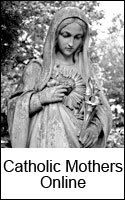 |
| Trinity Knot beads |
I've always loved this symbol of the Trinity, sometimes called the Triquetra. Who doesn't love those beautiful Celtic knots? They are elegant, intricate, and awe-inspiring. It's no wonder that Catholics have taken this symbol from ancient Celtic Tradition for their own and made it into symbol of the Holy Trinity- the central theme of our Faith. The three parts of the triangle symbolize the Three Persons of the Holy Trinity: Father, Son and Holy Spirit; while the never ending knot symbolizes the God- with no end and no beginning- the Alpha and the Omega. Three in One is also represented. Three sides of the triangle, yet one triangle.
Unfortunatly, this symbol is also used by pagans still today as seen in the show, Charmed. I didn't know of it's pagan roots until I started researching it. But just like many of the Christian Feast Days we have today, Catholics have taken something previously ungodly and made it holy. God be praised!
I was very nervous about making this bead. There is so much that can go wrong. It's not like I can take strings of clay to make a knot! I had to use awkward slabs of yellow clay outlined in black-- in just the right places-- to make it
appear knotted. By the grace of God, I chose the right clay for the background that had the right consistency and made the symbol stay intact perfectly. If you remember some of my other flubs, this isn't always the case!
 |
| Finished Cane |
For some reason, I was feeling rather adventurous and wanted to make the background into an arabesque lattice. Hmmmm....leave it to me to make something more complicated than it has to be! Well, it did turn out, but you can only see in in the large beads (which I knew was going to happen-having arabesque on the brain, I just had to throw it in). The whole pattern would have been more unified had I had twice as much green clay (I ran out near the end). However, I am glad that I didn't continue with the lattice because the triangle shape is very striking for this bead. Also, all those colors from the pattern turned into a lovely shade of emerald- Perfect!
I may do some more with this bead- maybe some boy's pendants or Irish rosaries. I think it has potential for some interesting pieces.




















